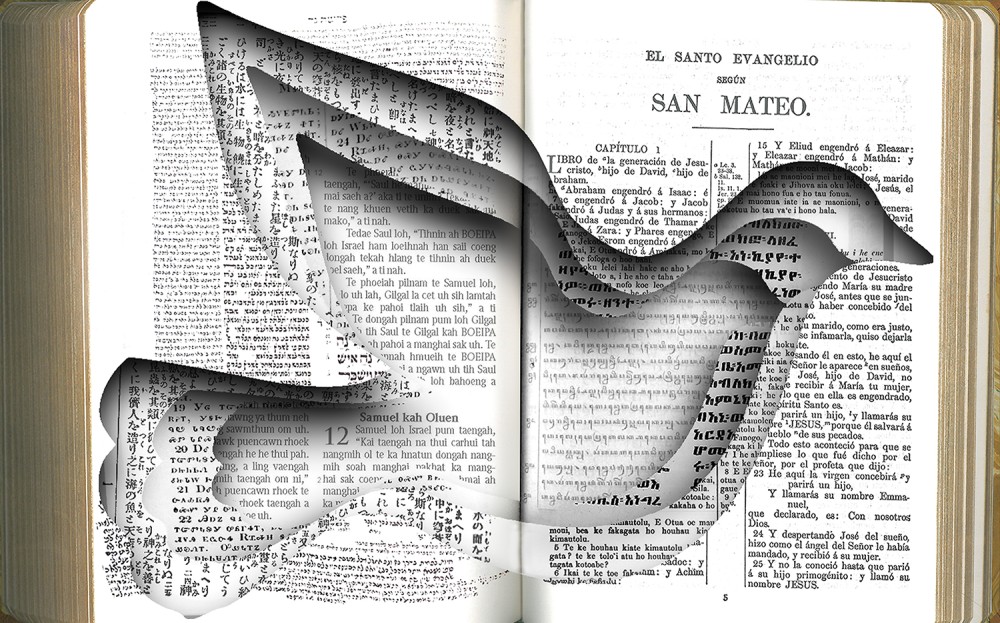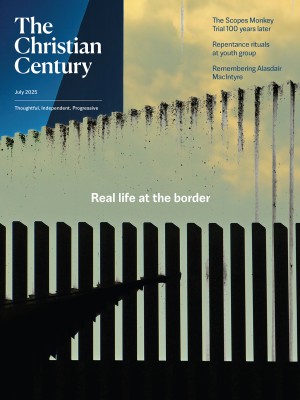What do we mean when we say something is “in the Bible”?
A new database of more than 900 biblical translations presents a prism of cultures, languages, and meanings.

Century illustration (Source images: Creative Commons)
Antoine de Saint-Exupéry’s classic novella The Little Prince has been translated into more than 600 languages and dialects, more than any other nonreligious work in history. Translation of this magnitude is truly a mind-blowing feat, a powerful and ever-growing monument to this beloved story of friendship, love, and seeing with the heart.
My own experience with Bible translation makes me wonder whether the English readers of The Little Prince, the Basque readers of the Printze txikia, and the Zulu readers of the Inkosana Encane are all reading the book in the same manner. Do they approach this book as an original book in their own language, or do they recognize its universal themes packaged into a World War II French pilot’s semi-autobiographical tale that was then successfully translated into their language? In other words, how do we view this text as we read it?
Read our latest issue or browse back issues.
There are seven different translations of Le Petit Prince into English, but of course most readers are not going to go back and compare their favorite translation with the French original in detail. We just don’t read most literature like that. Instead, readers love the story and yearn for its message: deeper relationships that allow us to see things that are “invisible to the eyes.”
But with the Bible, the stakes go up. When we say that something is “in the Bible,” what do we mean? Is it the exact translated text? Or the original Greek, Hebrew, or Aramaic text that we assume is well represented in the translated text? Or maybe it’s no specific text at all but more of an idea of “the message of the Bible”?
In the 1973 translation of the Psalms by the Jewish Publication Society, the preface acknowledges a problem that resonates with most biblical translators: “For many passages, our as yet imperfect understanding of the language of the Bible or what appears to be some disorder in the Hebrew text makes sure translation impossible.” The translators of the Swedish Bibel 2000 declared 69 Old Testament verses to be untranslatable and accordingly declined to translate them. In addition to the problem of not understanding the languages in which the Bible was written, Bible translators also face the reality that multiple manuscripts contain different versions of a single text, and sometimes there are disagreements as to which one is authoritative.
This presents a very different scenario from The Little Prince. The Bible (at least parts of it) has been translated into vastly more languages (about 3,500) and multiple times over in many of those languages (about 900 times in English alone). The source text of The Little Prince is completely static. No one questions its authenticity; in fact, the original French manuscript is still in existence.
Likewise, the language used by Saint-Exupéry is current enough that it remains completely accessible for those who read and understand modern French. Contrast that with the languages of the Bible, which no one speaks today. Many have studied them, of course, but no one knows them as living languages and can evaluate them as such.
Given this reality, can a text made up of so many non-primary manuscripts in ancient languages function as an authoritative text in the same way that Saint-Exupéry’s text is authoritative to its many translations?
One thing we do have access to in the contemporary moment is a recognition of the multiplicity of both source and translation. This is a great gift, if we are to follow Paul in seeking “words not taught by human wisdom but taught by the Spirit” (1 Cor. 2:13). According to Paul, understanding God’s word, scripture, is not possible without the Spirit of God’s Word, Jesus.
It’s easy to be impressed by the fancy charts that display the ever-growing number of languages in which Bible translations are being published, or the number of languages that are being worked on at any point in time. But it’s something altogether more profound to look behind that amazing, hyper-multilingual effort of the past, present, and future. Every time a part of scripture is translated and people in that language begin to read and use that translation, Christians meet God in a new language, through a new cultural mindset, in a new way.
Despite all of this almost overwhelming multiplicity, it is fascinating that the Bible translation movement is less fragmented than the rest of the church. A very large percentage of Bible translators, no matter what organization they are associated with or what confession they are part of, use the same rich set of tools—tools that give them access to the latest in scholarship and resources and equip them with ways to communicate with each other and, ultimately, with us.
Until a few years ago, I was mostly unaware of this relative cohesion of the Bible translation movement. While my academic work was on the history of Bible translation, since then I had worked as a technical translator. That’s a strange combination of experiences, but it helped me understand something important about translation in general and Bible translation in particular: like all translators, I discovered that a “perfect” translation is not possible. Complete and linear transfer of form and meaning between two languages is not achievable, no matter how closely those languages might be related. There is always something lost in translation.
But successful translation is still possible, because much can be gained in translation as well. Since linear and complete transfer from one language to another is unattainable, translators try to generate a text that becomes equivalent in its expressive force and meaning by transformation—by introducing, inevitably, changed elements and new ones.
After a lifetime of pondering the power and limitations of translation, I began to ask myself what implications this transformative process has for our understanding of the Bible. What if I could build a database to document those changed and new elements that have made their way into some—and maybe eventually all—of the languages into which the Bible has been translated? What if I could collect insightful terms, phrases, and constructs—and then go a step further to associate each with an explanation or a story or a translation into English, so that they were accessible to people who didn’t speak those languages? What if we could see the rich collection of translation materials in one place?
The result of this dream, under the auspices of United Bible Societies, is an online database called Translation Insights and Perspectives, at tips.translation.bible. This project is far from finished; in fact, it’s designed to be an ongoing work in progress. It will probably never be finished. Still, it already has a very large amount of data. There are more than 50,000 individual records, some of which have translations in dozens of the more than 900 languages that we have been able to collect data from at this point.
The idea behind it is both unique and head-spinning: an introduction for Christians (or really anyone) around the world into new and ongoing conversations with God. It includes the gospel in many of the more than 400 sign languages, as well as the gospel recited by individuals wearing the traditional garb of their people and singing the music of their own places. We hear the gospel told through dance, storytelling, and visual art, as well as, of course, the printed and digitally accessible written word. In each iteration, something truly new is translated. A new facet of what we can know about God becomes brighter.
Consider what this looks like in a specific example. Forgiveness plays a central role in human life, and it is a central concept in Christianity. But it is not a concept that is understood exactly the same way across languages and cultures. Over the course of curating data for TIPs, I’ve encountered many insightful ways of approaching and translating the concept of forgiveness that have challenged my own perceptions.
One is the translation of forgiveness into Ngbaka, spoken by approximately one million people in the Democratic Republic of the Congo. Here two terms can be used for forgive: ɛlɛ means “forgive and forget”; mbɔkɔ means “to excuse something.” Translators first used ɛlɛ when rendering the Bible in Ngbaka, but this was eventually aborted because the native translation team felt that people might well forgive but, unlike God, can’t forget. (See my Sunday’s Coming post for the CENTURY from August 18, 2023.)
Each language team in all of the world’s languages must grapple with similar complexities as they try to convey the most basic meaning of forgiveness, both God’s and ours. TIPs offers a graphical overview that summarizes the more detailed entries on forgive in many languages both familiar and unfamiliar. Each of these translations in TIPs has a corresponding entry with information about the location and culture of the language group and its translation into English. Many entries also have additional details about the context and discovery of the term.
This prismatic picture of the meaning of forgiveness never fails to challenge and broaden my idea of what forgiveness entails. None of these translations captures the concept completely. Nor does the English word forgive, which etymologically means “to give completely.” But taken together, they perhaps come closer to a perfect translation than any one of them on its own.
In the TIPs database, one way to access this data is by entering a book and verse. Then you can see the original text, a reference translation, and various records associated with different languages.
Each language evolved to suit the needs of its users. But each language is also limited by the constraints of its users and their traditions. This holds true for modern languages—those spoken widely as well as those struggling to survive—and it’s also true for ancient languages, including the original languages of biblical texts.
Modern English speakers, for instance, typically associate the terms heaven and sky with two different concepts. Biblical Hebrew and Greek speakers each had only one word here. Since English speakers (along with those of many other languages) make a distinction between a physical sky and a spiritual heaven that the original languages do not, you could argue that these languages have a leg up. Or you could argue that it makes the job of translators much harder, as the vast majority still translate “heaven and earth will pass away” in the synoptic gospels (Matt. 24:35; Mark 13:31; Luke 21:33) when technically it should be “sky and earth will pass away.”
The 40,000 speakers of Highland Tzeltal in southern Mexico do not have more than one word for “wisdom,” but they make interesting distinctions that illuminate the word in English as well as in Tzeltal. When the language team translated the book of Proverbs, they variously used p’ijil-o’tanil for “heart wisdom,” p’ijil c’op for “word wisdom” (also used for “knowledge”), and p’ijil jol for “head wisdom” (also used for “insight” or “understanding”) for the single Hebrew term in the original text. Highland Tzeltal speakers explore both “heart wisdom” and “head wisdom” in Proverbs 9:10: “The fear of the Lord is the beginning of heart wisdom, and the knowledge of the Holy One is head wisdom.” In Proverbs 1:7, Tzeltal speakers can compare head wisdom with word wisdom: “The fear of the Lord is the beginning of head wisdom; fools despise word wisdom and instruction.”
Now when I see the English word wisdom (or the Hebrew חָכְמָה) in my Bible reading, I’m deeply thankful for the more granular view Highland Tzeltal has given me, and I wonder how I ever managed to get by without differentiating between the wisdom that can be communicated and studied, the wisdom that presents the accumulation of what has been acquired, and wisdom that points to the spiritual world. (Perhaps p’ijil-o’tanil, “heart wisdom,” has much in common with The Little Prince’s “seeing with the heart.”)
The goal of TIPs is not to change or amend the text of the Bible; instead, the translations serve as a scriptural prism to reveal the many-colored details that are otherwise impossible to view. The original text of scripture in our various confessions is finite, but the enormous corpus of its translation into the world’s languages is ever growing.
As English readers, we are privileged to have a plethora of English translations to choose from, many of which are translated with the highest level of scholarship and intellectual honesty. Using several of those translations in our own Bible reading already serves as a prism to reveal additional colors. Beyond those resources, however, we can also have access to hundreds of other languages and their own journeys with scripture. It’s not that access in one language is not enough. But why not enjoy the fullest available spectrum of God’s colorful word?
This returns us to an earlier question: What do we mean when we say that something is “in the Bible”? “We do not need to hear Jesus in Aramaic,” writes Catholic scholar Paul Griffith. “We need to hear him in our multitude of mother tongues. . . . The meanings of all versions taken together constitute the meaning of the canon of Scripture.”
The church reads the Bible in translation, and it is those translations that—according to Paul, with the help of the Holy Spirit—equip and help to form the church. We live in an age in which we have access to unique data, including in languages we don’t speak or read. Let’s use it.
Christians who read Tagbanwa, a language in the Philippines spoken by just a few hundred people, have this assurance in their translation of Hebrews 4:12, translated back into English: “As for the word of God, it is no joking-matter. It can do much.”








